Is "What Doesn't Kill You Makes You Stronger" Terrible Advice?
Kintsugi, business failures and the Maginot Line
We’re all suckers for a good comeback story. Whether it’s the Phoenix rising from the ashes, Jesus from a tomb or Matthew McConaughey's acting career, we celebrate tales of perseverance, resilience and faith. We like to believe—or rather want to believe, that our current situation isn’t absolute—that there is always some way out of it. But do we truly get stronger from setbacks? After all, the dodo didn’t come back from extinction, many messiahs haven’t risen back to life, and there are plenty of Hollywood romcom actors who didn’t reinvent their careers.
For all the mythical, religious and Hollywood comebacks, there are many times more those that died a death, so is the prescription that “what doesn’t kill you, makes you stronger” true or not?
In today’s essay, we’ll learn what Kintsugi, business failures and the Maginot Line have to do with this question.
Our founding membership for The School of Knowledge Community will be opening soon. Thank you to those already on the list. If you haven't joined the waitlist yet, what are you waiting for?
A piece of beautiful terracotta pottery has been in your family for generations, displayed in many different eras but always with pride. People would always pay compliments to its beauty, elegance and timelessness, and you would always love telling new people the same old stories—where it came from, how old it is, who had it before you and so on.
But, one unfortunate day, you accidentally break the fragile pot, shattering generations of family pride along with it. To my knowledge, broken pottery can't be put back together the way it was before, so you're left with two options: (1) store away the broken pieces in an attempt to cling onto the family heirloom, or (2) throw the broken pottery, history and love in the bin. There is, however, a third option: Kintsugi.
Kintsugi (“golden joinery”) is the centuries-old Japanese practice of repairing broken pottery by mending the areas of breakage with lacquer mixed with powdered gold, silver, or platinum. Unlike most repair methods that aim to hide damage, Kintsugi deliberately highlights the fractures, and people go mad for this.
But why?
Pottery is, by nature, fragile because if it breaks, it loses its function and purpose. Kintsugi reverses the pot's fate. It gets stronger from shock and goes from being fragile to anti-fragile. It's a comeback story for the ages, and remember, we all love a good comeback story. It's a metaphor for all that can happen in our lives and shows that we can come back from being damaged, our dreams shattered, or our hearts broken. It resembles reality, not some static version of it. For most people, breakage is something to be avoided, but for some, it’s an opportunity to weld the broken pieces back together to create something greater than it was before. To adapt. These are the people who see an obstacle as a hurdle, not a barrier, and who strive for innovation.
This ancient Japanese art form offers more than aesthetic appeal—it provides a framework for understanding how damage might become a source of newfound strength. But pottery doesn’t repair itself. It requires skilled artisans, specialised materials, and deliberate technique. It requires practice.
Similarly, organisational recovery from failure isn’t automatic. It requires systems and cultures specifically designed to transform setbacks into strength. Few companies have embraced this philosophy more thoroughly than Amazon. But what skilled intervention is required for this repair process, and can organisations truly repair themselves in the same way?
“Failure and invention are inseparable twins. To invent, you have to experiment, and if you know in advance that it's going to work, it's not an experiment.” - Jeff Bezos
Jeff Bezos at Amazon embraced and encouraged his leadership team and employees to innovate. To try, fail, learn, and iterate. Bezos clearly lacks a crystal ball to foresee what will succeed or fail, but after launching numerous experiments, many of which were unsuccessful, he inevitably sharpens his ability to reverse the fate of failure into something greater. Before Amazon Prime came unboxed, which was a terrible attempt at entering the digital streaming platform. Being wrong can be costly, but being slow and wrong is worse. But, for all the success that Bezos and Amazon have enjoyed, there is a corporate graveyard of like-minded business owners that didn’t rise from the tomb. That did try to innovate. Bezos’s willingness to experiment and fail represents a corporate manifestation of a much older process—one that has been shaping life on Earth for billions of years. Evolution itself is essentially a system of trial and error, where most mutations fail but occasional successes fundamentally reshape what's possible.
Hundreds of millions of years ago, fish began to grow limbs, which enabled them to walk on the seabed and eventually onto land. From there, fish turned into mammals, which turned into sapiens, and eventually into us, sorry lot. If those fish hadn't mutated, survived, and multiplied, the world might not have been blessed with our current crop of politicians. Praise!
There's a natural and often oversimplified comparison between biological and business evolution, but for good reason. Conventional wisdom states that businesses should avoid failure at all costs, but if businesses stick to conventional wisdom, they're potentially giving themselves a death sentence by missing out on natural ‘business evolution.’ It's easy to embrace the idea of invention but harder to put into practice, because exercising your theoretical muscles and doing something for real are two very different things, because when businesses do things for real, they have to invest resources, time and capital. They open themselves up for breaking. But does the scale of failure matter? Are small, containable failures strengthening while big bets catastrophic?
In his 2015: Big Winners Pay for Many Experiments shareholder letter, Jeff Bezos provides a baseball analogy; the maximum points for a home run will always be four, but in business, the payoff isn't double, triple or ten times...it's potentially hundreds or thousands.
Amazon Prime was a natural segue for an e-commerce business, but AWS, Amazon Marketplace and Prime Video? They weren’t. When I buy running shoes from Nike, I'm not interested in their cloud storage capabilities or what TV series I can watch on their platform tonight, but Bezos had an insatiable appetite for overdelivering, and if you want to overdeliver, you're going to strike out. A lot. But do the benefits of learning from failure always outweigh the costs of the failures themselves?
"Outsized returns often come from betting against conventional wisdom, and conventional wisdom is usually right. Given a ten per cent chance of a 100 times payoff, you should take that bet every time. But you're still going to be wrong nine times out of ten." - Jeff Bezos
While Bezos demonstrates the innovative potential of embracing breakage and failure, history provides equally powerful examples of what happens when organisations commit exclusively to avoiding it. Perhaps no case illustrates this contrast more dramatically than France's infamous Maginot Line.
After the Germans were defeated in WW1 and thinking ahead to what those pesky Nazis might do in the future, the French decided it best to protect their interests and build a line of concrete fortifications, obstacles, and weaponry named after the French Minister of War André Maginot, which would finally put them at arm's length from their over-ambitious and nefarious neighbours.
The problem with this type of “Kintsugi” is that it belonged in the 1910s and not the 1940s. A lot can happen in 30 years. Indeed, the Germans, bankrupt, embarrassed, and sent to the world's metaphorical naughty corner, developed something so extraordinarily novel it birthed its own name: Blitzkrieg. And it was something else. The Maginot Line was about as good a defence as a chocolate fireguard, and as the Germans ravaged their way to Paris, it developed its own signature branding: “For expensive things that offer a false sense of security.”
The Germans’ and French attitudes to fragility couldn’t have been more contrast. If your attitude to fixing broken pottery is to send it back in time, don’t be surprised when the future comes steamrolling over it.
Setbacks don't inherently strengthen us because the laws of the world don’t prescribe to platitudes. Rather, they create the conditions where strength becomes possible—but only for those equipped with the right mindset, resources, and systems to learn effectively. It isn’t “What doesn’t kill you makes you stronger,” but rather, “Are you willing to pick yourself and the pieces up and try?” By adding nuance, we move beyond inspirational and pithy platitudes toward a more practical understanding of how failure can sometimes lead to extraordinary growth.
Until next time, Karl (The School of Knowledge).
The School of Knowledge community launches on May 13th. It's where thoughtful professionals in transition learn from practitioners with real skin in the game. Inside our community, you'll find:
Deeper discussions on systems thinking and mental models
Direct application of concepts to real-world challenges
Connection with others navigating similar transitions
Weekly prompts and discussions led by practitioners
Our founding membership will be opening soon. Thank you to those already on the list. If you haven't joined the waitlist yet, what are you waiting for?
Whenever you’re ready
The School of Knowledge helps you understand the world through practitioners. Those who try, fail and do (skin in the game). 📚💡
Join our growing community of 5,647 lifelong learners here:





Wow, Karl! There's so much to unpack here. I recently learned about the concept of Kintsugi and absolutely love it.
And I agree — ‘what doesn’t kill you makes you stronger’ only holds true if you have a certain amount of strength to begin with.
I believe that phrase has always been nuanced.
We decompose and resynthesize to different requirements (hopefully better requirements), that change our inputs and ultimately impact our outputs/outcomes.
I love how you took examples from multiple fields to shape this article!